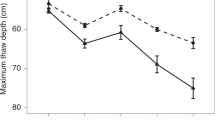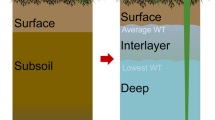Abstract
Old soil carbon (C) respired to the atmosphere as a result of permafrost thaw has the potential to become a large positive feedback to climate change. As permafrost thaws, quantifying old soil contributions to ecosystem respiration (Reco) and understanding how these contributions change with warming is necessary to estimate the size of this positive feedback. We used naturally occurring C isotopes (δ13C and Δ14C) to partition Reco into plant, young soil and old soil sources in a subarctic air and soil warming experiment over three years. We found that old soil contributions to Reco increased with soil temperature and Reco flux. However, the increase in the soil warming treatment was smaller than expected because experimentally warming the soils increased plant contributions to Reco by 30%. On the basis of these data, an increase in mean annual temperature from −5 to 0 °C will increase old soil C losses from moist acidic tundra by 35–55 g C m−2 during the growing season. The largest losses will probably occur where the plant response to warming is minimal.
This is a preview of subscription content, access via your institution
Access options
Subscribe to this journal
Receive 12 print issues and online access
$209.00 per year
only $17.42 per issue
Buy this article
- Purchase on Springer Link
- Instant access to full article PDF
Prices may be subject to local taxes which are calculated during checkout




Similar content being viewed by others
References
Tarnocai, C. et al. Soil organic carbon pools in the northern circumpolar permafrost region. Glob. Biogeochem. Cycles 23, GB2023 (2009).
Hicks Pries, C. E., Schuur, E. A. G. & Crummer, K. G. Holocene carbon stocks and carbon accumulation rates altered in soils undergoing permafrost thaw. Ecosystems 15, 162–173 (2012).
Czimczik, C. & Welker, J. Radiocarbon content of CO2 respired from high Arctic tundra in northwest Greenland. Arct. Antarct. Alp. Res. 42, 342–350 (2010).
IPCC Climate Change 2013: The Physical Science Basis (eds Stocker, T. F. et al.) (Cambridge Univ. Press, 2013).
Koven, C. D., Riley, W. J. & Stern, A. Analysis of permafrost thermal dynamics and response to climate change in the CMIP5 Earth system models. J. Clim. 26, 1877–1900 (2013).
Burke, E. J., Jones, C. D. & Koven, C. D. Estimating the permafrost-carbon climate response in the CMIP5 climate models using a simplified approach. J. Clim. 26, 4897–4909 (2013).
Osterkamp, T. E. Characteristics of the recent warming of permafrost in Alaska. J. Geophys. Res. 112, F02S02 (2007).
Elberling, B. et al. Long-term CO2 production following permafrost thaw. Nature Clim. Change 3, 890–894 (2013).
Brutsaert, W. & Hiyama, T. The determination of permafrost thawing trends from long-term streamflow measurements with an application in eastern Siberia. J. Geophys. Res. 117, 1984–2012 (2012).
Kuhry, P. et al. Characterisation of the permafrost carbon pool. Permafrost Periglac. Process. 24, 146–155 (2013).
Raich, J. W. & Schlesinger, W. H. The global carbon dioxide flux in soil respiration and its relationship to vegetation and climate. Tellus B 44, 81–99 (1992).
Oberbauer, S. F. et al. Tundra CO2 fluxes in response to experimental warming across latitudinal and moisture gradients. Ecol. Monogr. 77, 221–238 (2007).
Hobbie, S. E. & Chapin, F. S. III The response of tundra plant biomass, aboveground production, nitrogen, and CO2 flux to experimental warming. Ecology 79, 1526–1544 (1998).
Dorrepaal, E. et al. Carbon respiration from subsurface peat accelerated by climate warming in the subarctic. Nature 460, 616–619 (2009).
Natali, S. M., Schuur, E. A., Webb, E. E., Hicks Pries, C. E. & Crummer, K. G. Permafrost degradation stimulates carbon loss from experimentally warmed tundra. Ecology 95, 602–608 (2014).
Sharp, E. D., Sullivan, P. F., Steltzer, H., Csank, A. Z. & Welker, J. M. Complex carbon cycle responses to multi-level warming and supplemental summer rain in the high Arctic. Glob. Change Biol. 19, 1780–1792 (2013).
Lambers, H. III et al. Plant Physiological Ecology (Springer, 2008).
Davidson, E. A. & Janssens, I. A. Temperature sensitivity of soil carbon decomposition and feedbacks to climate change. Nature 440, 165–173 (2006).
Dioumaeva, I. et al. Decomposition of peat from upland boreal forest: Temperature dependence and sources of respired carbon. J. Geophys. Res. 107, 8222 (2002).
Hicks Pries, C. E., Schuur, E. A. G. & Crummer, K. G. Thawing permafrost increases old soil and autotrophic respiration in tundra: Partitioning ecosystem respiration using δ13C and Δ14C. Glob. Change Biol. 19, 649–661 (2013).
Schirrmeister, L. et al. Fossil organic matter characteristics in permafrost deposits of the northeast Siberian Arctic. J. Geophys. Res. 116, 2005–2012 (2011).
Schuur, E. A. G. et al. The effect of permafrost thaw on old carbon release and net carbon exchange from tundra. Nature 459, 556–559 (2009).
Ehleringer, J. R., Buchmann, N. & Flanagan, L. B. Carbon isotope ratios in belowground carbon cycle processes. Ecol. Appl. 10, 412–422 (2000).
Trumbore, S. Age of soil organic matter and soil respiration: Radiocarbon constraints on belowground C dynamics. Ecol. Appl. 10, 399–411 (2000).
Phillips, D. L. & Gregg, J. W. Source partitioning using stable isotopes: Coping with too many sources. Oecologia 136, 261–269 (2003).
Bowling, D. R., McDowell, N. G., Bond, B. J., Law, B. E. & Ehleringer, J. R. 13C content of ecosystem respiration is linked to precipitation and vapor pressure deficit. Oecologia 131, 113–124 (2002).
Natali, S. M. et al. Effects of experimental warming of air, soil and permafrost on carbon balance in Alaskan tundra. Glob. Change Biol. 17, 1394–1407 (2011).
Lupascu, M. et al. High Arctic wetting reduces permafrost carbon feedbacks to climate warming. Nature Clim. Change 4, 51–55 (2014).
Nowinski, N. S., Taneva, L., Trumbore, S. E. & Welker, J. M. Decomposition of old organic matter as a result of deeper active layers in a snow depth manipulation experiment. Oecologia 163, 785–792 (2010).
Hardie, S. M. L., Garnett, M. H., Fallick, A. E., Ostle, N. J. & Rowland, A. P. Bomb-14C analysis of ecosystem respiration reveals that peatland vegetation facilitates release of old carbon. Geoderma 153, 393–401 (2009).
Hicks Pries, C. E., Schuur, E. A. G., Vogel, J. G. & Natali, S. M. Moisture drives surface decomposition in thawing tundra. J. Geophys. Res. 118, 1133–1143 (2013).
Natali, S. M., Schuur, E. A. & Rubin, R. L. Increased plant productivity in Alaskan tundra as a result of experimental warming of soil and permafrost. J. Ecol. 100, 488–498 (2012).
Amthor, J. S. The McCree–de Wit–Penning de Vries–Thornley respiration paradigms: 30 years later. Ann. Bot. 86, 1–20 (2000).
Shaver, G. R. et al. Biomass and CO2 flux in wet sedge tundras: Responses to nutrients, temperature, and light. Ecol. Monogr. 68, 75–97 (1998).
Rustad, L. et al. A meta-analysis of the response of soil respiration, net nitrogen mineralization, and aboveground plant growth to experimental ecosystem warming. Oecologia 126, 543–562 (2001).
Keuper, F. et al. A frozen feast: Thawing permafrost increases plant-available nitrogen in subarctic peatlands. Glob. Change Biol. 18, 1998–2007 (2012).
Blagodatskaya, E. & Kuzyakov, Y. Mechanisms of real and apparent priming effects and their dependence on soil microbial biomass and community structure: Critical review. Biol. Fert. Soils 45, 115–131 (2008).
Hicks Pries, C. E. et al. Decadal warming causes a consistent and persistent shift from heterotrophic to autotrophic respiration in contrasting permafrost ecosystems. Glob. Change Biol. http://dx.doi.org/10.1111/gcb.13032 (2015).
Belshe, E. F., Schuur, E. A. G. & Bolker, B. M. Tundra ecosystems observed to be CO2 sources due to differential amplification of the carbon cycle. Ecol. Lett. 16, 1307–1315 (2013).
Grant, R. F., Humphreys, E. R., Lafleur, P. M. & Dimitrov, D. D. Ecological controls on net ecosystem productivity of a mesic arctic tundra under current and future climates. J. Geophys. Res. 116, 2005–2012 (2011).
Schuur, E. A. G. et al. Expert assessment of vulnerability of permafrost carbon to climate change. Clim. Change 119, 359–374 (2013).
Bauer, J. E., Williams, P. M. & Druffel, E. R. Recovery of submilligram quantities of carbon dioxide from gas streams by molecular sieve for subsequent determination of isotopic carbon-13 and carbon-14 natural abundances. Anal. Chem. 64, 824–827 (1992).
Vogel, J. S., Nelson, D. E. & Southon, J. R. 14C background levels in an accelerator mass spectrometry system. Radiocarbon 29, 323–333 (1987).
Midwood, A. J. et al. Collection and storage of CO2 for 13C analysis: An application to separate soil CO2 efflux into root-and soil-derived components. Rapid Commun. Mass Spectrom. 20, 3379–3384 (2006).
Högberg, P. et al. Large-scale forest girdling shows that current photosynthesis drives soil respiration. Nature 411, 789–792 (2001).
Lavoie, M., Mack, M. C. & Schuur, E. a. G. Effects of elevated nitrogen and temperature on carbon and nitrogen dynamics in Alaskan arctic and boreal soils. J. Geophys. Res. 116, G03013 (2011).
Lee, H., Schuur, E. A., Inglett, K. S., Lavoie, M. & Chanton, J. P. The rate of permafrost carbon release under aerobic and anaerobic conditions and its potential effects on climate. Glob. Change Biol. 18, 515–527 (2012).
Stuiver, M., Reimer, P. & Reimer, R. CALIB Radiocarbon Calibration (2013); http://calib.qub.ac.uk/calib
Andrews, J. A., Matamala, R., Westover, K. M. & Schlesinger, W. H. Temperature effects on the diversity of soil heterotrophs and the δ13C of soil-respired CO2 . Soil Biol. Biochem. 32, 699–706 (2000).
Parnell, A. C., Inger, R., Bearhop, S. & Jackson, A. L. Source partitioning using stable isotopes: Coping with too much variation. PLoS ONE 5, e9672 (2010).
R Development Core Team R: A Language and Environment for Statistical Computing (R Foundation for Statistical Computing, 2014); http://www.R-project.org
Risk, D., Kellman, L. & Beltrami, H. Carbon dioxide in soil profiles: Production and temperature dependence. Geophys. Res. Lett. 29, 11-1–11-4 (2002).
Zuur, A. et al. Mixed Effects Models and Extensions in Ecology with R (Springer, 2009).
Pinheiro, J. et al. nlme: Linear and Nonlinear Mixed Effects Models (2013); http://CRAN.R-project.org/package=nlme
Mazerolle, M. Model Selection and Multimodel Inference Based on (Q)AIC(c) (2014); http://cran.r-project.org/web/packages/AICcmodavg/AICcmodavg.pdf
Acknowledgements
This work was made possible by assistance from J. Curtis, K. Venz-Curtis, A. B. Lopez, D. DeRaps, D. Rogan, E. Pegoraro and D. Hicks. This work was funded by NSF DDIG (C.E.H.P.), NSF CAREER (E.A.G.S.), Bonanza Creek LTER (E.A.G.S.), DOE NICCR and NSF OPP (S.M.N. and E.A.G.S.).
Author information
Authors and Affiliations
Contributions
E.A.G.S. conceived and designed the warming experiment; S.M.N. designed and set up the warming experiment; C.E.H.P. designed the partitioning measurements, performed the field and lab work, analysed the data, and wrote the paper; K.G.C. performed lab analyses.
Corresponding author
Ethics declarations
Competing interests
The authors declare no competing financial interests.
Supplementary information
Rights and permissions
About this article
Cite this article
Hicks Pries, C., Schuur, E., Natali, S. et al. Old soil carbon losses increase with ecosystem respiration in experimentally thawed tundra. Nature Clim Change 6, 214–218 (2016). https://doi.org/10.1038/nclimate2830
Received:
Accepted:
Published:
Issue Date:
DOI: https://doi.org/10.1038/nclimate2830
This article is cited by
-
Climate warming restructures food webs and carbon flow in high-latitude ecosystems
Nature Climate Change (2024)
-
Changes in the non-growing season soil heterotrophic respiration rate are driven by environmental factors after fire in a cold temperate forest ecosystem
Annals of Forest Science (2021)
-
Effect of drainage on microbial enzyme activities and communities dependent on depth in peatland soil
Biogeochemistry (2021)
-
Time-lapse electrical resistivity tomography and ground penetrating radar mapping of the active layer of permafrost across a snow fence in Cambridge Bay, Nunavut Territory, Canada: correlation interpretation using vegetation and meteorological data
Geosciences Journal (2021)
-
Winter warming in Alaska accelerates lignin decomposition contributed by Proteobacteria
Microbiome (2020)



